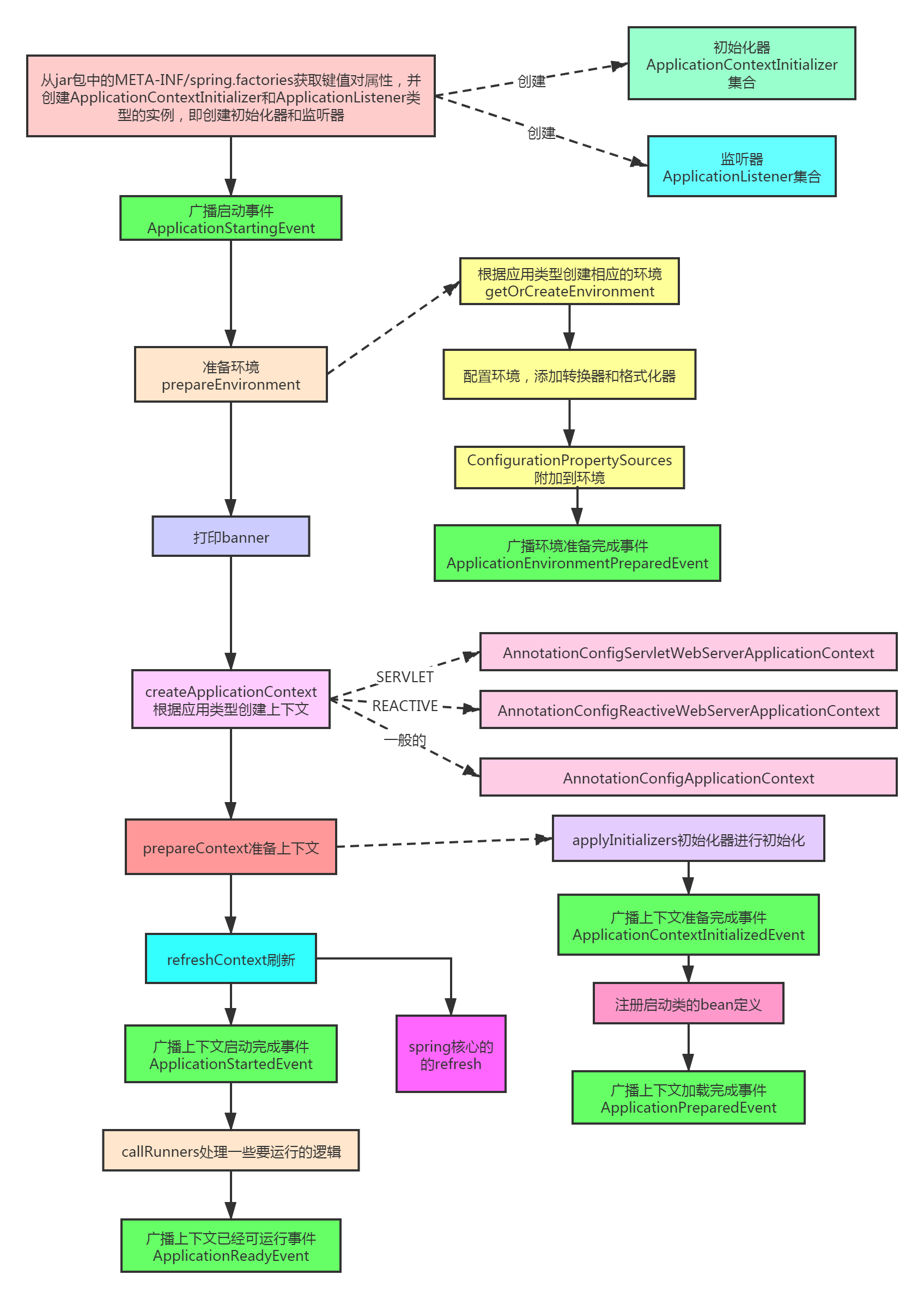研究源码的目的其实是为了更好的使用,和更好的扩展,当然是为了实际项目服务,解决问题,不是为了看而看,只有真正了解了原理,你才可以用的得心应手,出了问题也不怕,万变不离其宗。
初始化基本流程

SpringApplication.run
我们从最简单的例子开始,就这些东西,我们看看SpringApplication.run到底做了什么事。

内部还有run:

这次是关键:

SpringApplication构造方法

首先创建一个集合存放我们传进去的类,然后推断应用程序的类型,是SERVLET,还是REACTIVE,然后获取很多jar包下的META-INF/spring.factories中的org.springframework.context.ApplicationContextInitializer属性的值和org.springframework.context.ApplicationListener属性的值,其实他们是接口,他们的值就是其实就是实现类,也就是说要获取这些接口的实现类,来做一些初始化工作,当然里面会做一些筛选,去重。然后推断出main方法的类,他用了一种很巧妙的方式,抛出一个异常,然后再方法栈里找有main方法的那个类,具体的细节后面会说。
1
2
3
4
5
6
7
8
9
10
11
12
13
14
15
16
17
18
19
20
21
22
| public SpringApplication(ResourceLoader resourceLoader, Class<?>... primarySources) {
this.sources = new LinkedHashSet();
this.bannerMode = Mode.CONSOLE;
this.logStartupInfo = true;
this.addCommandLineProperties = true;
this.addConversionService = true;
this.headless = true;
this.registerShutdownHook = true;
this.additionalProfiles = Collections.emptySet();
this.isCustomEnvironment = false;
this.lazyInitialization = false;
this.applicationContextFactory = ApplicationContextFactory.DEFAULT;
this.applicationStartup = ApplicationStartup.DEFAULT;
this.resourceLoader = resourceLoader;
Assert.notNull(primarySources, "PrimarySources must not be null");
this.primarySources = new LinkedHashSet(Arrays.asList(primarySources));
this.webApplicationType = WebApplicationType.deduceFromClasspath();
this.bootstrapRegistryInitializers = new ArrayList(this.getSpringFactoriesInstances(BootstrapRegistryInitializer.class));
this.setInitializers(this.getSpringFactoriesInstances(ApplicationContextInitializer.class));
this.setListeners(this.getSpringFactoriesInstances(ApplicationListener.class));
this.mainApplicationClass = this.deduceMainApplicationClass();
}
|
WebApplicationType的deduceFromClasspath推断Web应用程序类型
要对照这些类看:

这个逻辑我就不讲了,就是排他的,要么REACTIVE,要么SERVLET,要么就普通的。具体是根据Class.forName反射的,而且如果一次不行,还会进行内部类的反射,否没有的话才捕获异常,返回false。可以看到如果同时有REACTIVE和SERVLET的相关类,会判定是SERVLET。
1
2
3
4
5
6
7
8
9
10
11
12
13
14
15
16
17
| static WebApplicationType deduceFromClasspath() {
if (ClassUtils.isPresent("org.springframework.web.reactive.DispatcherHandler", (ClassLoader)null) && !ClassUtils.isPresent("org.springframework.web.servlet.DispatcherServlet", (ClassLoader)null) && !ClassUtils.isPresent("org.glassfish.jersey.servlet.ServletContainer", (ClassLoader)null)) {
return REACTIVE;
} else {
String[] var0 = SERVLET_INDICATOR_CLASSES;
int var1 = var0.length;
for(int var2 = 0; var2 < var1; ++var2) {
String className = var0[var2];
if (!ClassUtils.isPresent(className, (ClassLoader)null)) {
return NONE;
}
}
return SERVLET;
}
}
|
ClassUtils的isPresent是否存在类型
1
2
3
4
5
6
7
8
9
10
| public static boolean isPresent(String className, @Nullable ClassLoader classLoader) {
try {
forName(className, classLoader);
return true;
} catch (IllegalAccessError var3) {
throw new IllegalStateException("Readability mismatch in inheritance hierarchy of class [" + className + "]: " + var3.getMessage(), var3);
} catch (Throwable var4) {
return false;
}
}
|
ClassUtils的forName(底层也是用的反射)
留下了主要的代码,Class.forName,都没有就抛异常。
1
2
3
4
5
6
7
8
9
10
11
12
13
14
15
16
17
18
19
20
21
22
23
24
25
26
27
28
29
30
31
32
33
34
35
36
37
38
39
40
41
42
43
44
45
46
47
48
49
| public static Class<?> forName(String name, @Nullable ClassLoader classLoader) throws ClassNotFoundException, LinkageError {
Assert.notNull(name, "Name must not be null");
Class<?> clazz = resolvePrimitiveClassName(name);
if (clazz == null) {
clazz = (Class)commonClassCache.get(name);
}
if (clazz != null) {
return clazz;
} else {
Class elementClass;
String elementName;
if (name.endsWith("[]")) {
elementName = name.substring(0, name.length() - "[]".length());
elementClass = forName(elementName, classLoader);
return Array.newInstance(elementClass, 0).getClass();
} else if (name.startsWith("[L") && name.endsWith(";")) {
elementName = name.substring("[L".length(), name.length() - 1);
elementClass = forName(elementName, classLoader);
return Array.newInstance(elementClass, 0).getClass();
} else if (name.startsWith("[")) {
elementName = name.substring("[".length());
elementClass = forName(elementName, classLoader);
return Array.newInstance(elementClass, 0).getClass();
} else {
ClassLoader clToUse = classLoader;
if (classLoader == null) {
clToUse = getDefaultClassLoader();
}
try {
return Class.forName(name, false, clToUse);
} catch (ClassNotFoundException var9) {
int lastDotIndex = name.lastIndexOf(46);
if (lastDotIndex != -1) {
String var10000 = name.substring(0, lastDotIndex);
String nestedClassName = var10000 + "$" + name.substring(lastDotIndex + 1);
try {
return Class.forName(nestedClassName, false, clToUse);
} catch (ClassNotFoundException var8) {
}
}
throw var9;
}
}
}
}
|
啰嗦的有点多,不好意思了,下次补上。
好了,今天就到这里了,希望对学习理解有帮助,大神看见勿喷,仅为自己的学习理解,能力有限




 首先创建一个集合存放我们传进去的类,然后推断应用程序的类型,是SERVLET,还是REACTIVE,然后获取很多jar包下的META-INF/spring.factories中的org.springframework.context.ApplicationContextInitializer属性的值和org.springframework.context.ApplicationListener属性的值,其实他们是接口,他们的值就是其实就是实现类,也就是说要获取这些接口的实现类,来做一些初始化工作,当然里面会做一些筛选,去重。然后推断出main方法的类,他用了一种很巧妙的方式,抛出一个异常,然后再方法栈里找有main方法的那个类,具体的细节后面会说。
首先创建一个集合存放我们传进去的类,然后推断应用程序的类型,是SERVLET,还是REACTIVE,然后获取很多jar包下的META-INF/spring.factories中的org.springframework.context.ApplicationContextInitializer属性的值和org.springframework.context.ApplicationListener属性的值,其实他们是接口,他们的值就是其实就是实现类,也就是说要获取这些接口的实现类,来做一些初始化工作,当然里面会做一些筛选,去重。然后推断出main方法的类,他用了一种很巧妙的方式,抛出一个异常,然后再方法栈里找有main方法的那个类,具体的细节后面会说。
